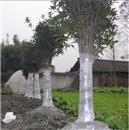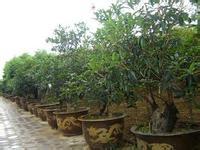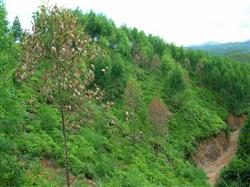Cultivation and Utilization of Osmanthus fragrans

Osmanthus fragrans is an evergreen small tree. It is a precious ornamental aromatic plant. It blooms in autumn, and its fragrance is far away. Osmanthus can extract aromatic oil, is a valuable spice. Fragrance and perfuming products formulated with pure osmanthus oil, such as osmanthus wine, osmanthus sugar, osmanthus preserves, perfume, soap, etc., sell well in domestic and foreign markets. 1. There are many varieties of Osmanthus fragrans, such as Jingui, Yingui, Dangui, Sigui, Yuegui, etc. Among them, Osmanthus fragrans has rich aroma, many flowers, high ornamental and economic value. Osmanthus flowers have a long period of four seasons. They bloom except in winter and summer. They bloom most in autumn. However, the tree type is short and the fragrance is light. It is only suitable for garden planting and viewing. 2. Propagation methods Osmanthus fragrans can be propagated by sowing, docking, cutting, layering, cuttage and other methods, generally based on docking and cuttage propagation. The grafted rootstock is Ligustrum microphylla, which can flower in the same year after grafting, and the grafting time is mostly in summer. A large number of Osmanthus fragrans seedlings can be propagated by cutting method, and the time should be selected in February when the sap is about to flow. In order to promote rooting and prevent diseases, cuttings were sprayed with 800-1000 times trichlorfon solution one month before cutting, disinfected with lime water 10-15 days before cutting, and soaked in 10 ppm naphthylacetic acid solution for 8-10 hours before cutting. Immediately after cuttage irrigation through water, and often maintain a certain humidity, but also in the seedling bed above the establishment of shade net. Rooting takes place after about 2 months. Transplant once in the second year, and plant in the third year. 3, cultivation points osmanthus love dry, in addition to transplanting pay attention to watering moisture, generally do not need irrigation, so require good soil drainage. Usually the tree shoots once a year, and the young tree shoots 2-3 times. Can be in June, September, December or flowering before the flowering of fertilizer once a year. In the early stage of spring germination, heavy fertilizer should not be applied, and pig dung and bean cake should be used as fertilizer. From May to October, cultivation, loosening and weeding should be carried out in time to maintain soil moisture and avoid weeds and trees competing for fertilizer. Osmanthus fragrans has developed roots, more fibrous roots, strong adaptability, easy to transplant and survive, generally under 20 years old, easy to transplant and survive in spring and autumn. 4. Harvest and processing When flowering in September and October, harvest osmanthus, mix it with alum (3.5%) and compact it, squeeze it to keep the weight of the original flower after a few days, and then add the same amount of sugar and mix well. It can be used as osmanthus steamed stuffed bun, osmanthus dumpling, osmanthus wine and osmanthus preserved fruit raw materials for later use. The osmanthus fragrans can also be extracted with petroleum ether as solvent, the extract is clarified, filtered, concentrated under normal pressure and low pressure, and finally deetherized to obtain osmanthus fragrans extract. The yield of Osmanthus fragrans extract was about 0.17%. The extract repeatedly extracted with ethanol, osmanthus can be prepared pure oil, which is a natural precious spice. Osmanthus fragrans residue after extraction, adding appropriate amount of osmanthus fragrans essence and white sugar, becomes osmanthus fragrans sugar, which can be used to prepare general food.
- Prev

On the Landscape Art of Osmanthus fragrans
Osmanthus fragrans is one of the ten traditional famous flowers in China. It is a special ornamental flower and fragrant tree species in China. Its shape, color, fragrance and rhyme are excellent. Because of its "winter glory of the good osmanthus tree", "do not give up because of the small flowers, elegant fragrance, rich Fu Zhiyuan" and other qualities, it has been favored by literati throughout the ages, and because of its relationship with Chang'e running to the moon.
- Next

Bacterial wilt of eucalyptus and its control
Bacterial wilt of eucalyptus and its control Ralstoniasolanacearum (Smith) Yabuuchi is a serious bacterial wilt disease of eucalyptus in South China. The seedlings generally wilted at the initial stage of the disease, followed by leaf withering, rapid death of the seedlings, necrosis of the roots of the diseased plants, and waterlogging.
Related
- Fuxing push coffee new agricultural production and marketing class: lack of small-scale processing plants
- Jujube rice field leisure farm deep ploughing Yilan for five years to create a space for organic food and play
- Nongyu Farm-A trial of organic papaya for brave women with advanced technology
- Four points for attention in the prevention and control of diseases and insect pests of edible fungi
- How to add nutrient solution to Edible Fungi
- Is there any good way to control edible fungus mites?
- Open Inoculation Technology of Edible Fungi
- Is there any clever way to use fertilizer for edible fungus in winter?
- What agents are used to kill the pathogens of edible fungi in the mushroom shed?
- Rapid drying of Edible Fungi

